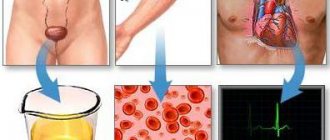When should you get tested for cortisol?
It is necessary to check cortisol levels in women if there are interruptions in the menstrual cycle (oligomenorrhea) or excessive hair growth (hirsutism). Other manifestations in which it is necessary to take a cortisol test in women and men:
• Too early puberty;
• Osteoporosis;
• Disorders of skin pigmentation (hyperpigmentation most often occurs in open areas of the skin, places of friction of clothing, on mucous membranes, in the area of skin folds, less often - areas of depigmentation appear on the skin in the form of spots), including when Addison's disease is suspected ("bronze disease"). disease" - the skin acquires a bronze tint);
• Pathological signs on the skin, for example, if Cushing's disease is suspected, when red-violet stripes appear on the skin;
• Development of muscle weakness;
• Acne in adults;
• Loss of body weight without an established reason;
• Arterial hypertension of unknown cause.
Complexes with this research
Stress complex Assessment of the state of the body during stress 4,310 R Composition
Three important indicators for a man Diagnosis of problems of the reproductive system 1,810 R Composition
Advanced female anti-aging diagnostics Advanced monitoring of basic blood parameters in women aged 40+ RUR 28,680 Composition
IN OTHER COMPLEXES
- Preventive check-up RUB 11,960
- Metabolic profile RUB 5,900
- Advanced male anti-aging diagnostics RUB 33,710
- Adrenogenital complex RUB 2,560
- Women's anti-aging diagnostics RUB 12,070
Tests for the hormone cortisol in women and men: explanation
Cortisol levels are elevated when adrenal function is increased. This condition is called hypercortisolism. Cases where cortisol is elevated do not always indicate adrenal disease.
An increase in the level of cortisol in the blood is caused by excessive formation of the hormone in the body or its entry from the outside (taking cortisol drugs - prednisolone, etc.).
Endogenous (internal) causes of increased cortisol in the blood and urine:
• Dysfunction of the pituitary gland. ACTH, or adrenocorticotropic hormone of the pituitary gland, is responsible for the production of cortisol in the body. ACTH production is disrupted:
— For Itsenko-Cushing's disease;
— Due to long-term use of medicinal ACTH analogues;
- When ACTH is produced by cells (often atypical) located outside the pituitary gland.
• Diseases of the adrenal glands. Excessive production of cortisol is possible with adrenal adenoma, as well as with carcinoma and hyperplasia of the tissue of these glands.
Cortisol
Cortisol is a hormone produced in the adrenal glands. Participates in the metabolism of proteins, fats, carbohydrates, and in the development of stress reactions.
Synonyms Russian
Hydrocortisone.
English synonyms
Compound F, Cortisol, Hydrocortisone.
Research method
Competitive enzyme-linked immunosorbent assay.
Determination range: 3 - 17500 nmol/l.
Units
Nmol/L (nanomoles per liter).
What biomaterial can be used for research?
Venous blood.
How to properly prepare for research?
- Do not eat for 12 hours before donating blood.
- Avoid taking estrogens and androgens 48 hours before the test.
- Avoid physical and emotional stress for 24 hours before the test.
- Do not smoke for 3 hours of blood donation.
General information about the study
Cortisol is a hormone that is produced in the adrenal cortex. It protects the body from stress, regulates blood pressure, and participates in the metabolism of proteins, fats and carbohydrates.
The release of cortisol is regulated by adrenocorticotropic hormone (ACTH), produced in the pituitary gland, a small gland located at the bottom of the brain. The concentrations of ACTH and cortisol in the blood are regulated by feedback. A decrease in cortisol concentration increases the production of ACTH, resulting in stimulation of the production of this hormone until it returns to normal. An increase in the concentration of cortisol in the blood, on the contrary, leads to a decrease in the production of ACTH.
Therefore, the concentration of cortisol in the blood can change with an increase or decrease in the secretion of both cortisol itself in the adrenal glands and ACTH in the pituitary gland, for example, with a pituitary tumor that secretes ACTH.
A decrease in cortisol production may be accompanied by nonspecific symptoms: weight loss, weakness, fatigue, decreased blood pressure, abdominal pain. When a combination of decreased cortisol production and severe stress occurs, an adrenal crisis sometimes develops, which requires emergency medical attention.
Excess cortisol leads to high blood pressure and blood sugar levels, obesity, thinning skin and the appearance of purple stretch marks on the sides of the abdomen.
What is the research used for?
- For the diagnosis of Itsenko-Cushing syndrome or disease and Addison's disease - serious endocrinological diseases.
- To assess the effectiveness of treatment of Itsenko-Cushing syndrome or disease and Addison's disease.
When is the study scheduled?
- If you suspect Itsenko-Cushing syndrome or disease (symptoms: high blood pressure, obesity, muscle dystrophy, abdominal stretch marks) or Addison's disease (symptoms: weakness, fatigue, low blood pressure, skin pigmentation).
- In cases of ineffectiveness of attempts to normalize high blood pressure.
- At certain intervals when the patient is being treated for Cushing's syndrome/disease or Addison's disease.
What do the results mean?
Reference values
For samples taken in the morning (6-10 hours): 166 - 507 nmol/l.
For samples taken in the evening hours (16-20 hours): 73.8 - 291 nmol/l.
Normally, cortisol levels are low in the evening and reach a maximum after waking up. If a person often works night shifts or does not follow a sleep schedule, then this rhythm may become disrupted. As a rule, it is also impaired in Itsenko-Cushing's disease.
Elevated or normal cortisol levels in morning samples without a decrease in the evening suggest excess cortisol production. Often, excess cortisol formation is associated with increased production of ACTH in the pituitary gland - Cushing's disease. This is usually caused by a pituitary adenoma, as well as tumors that produce ACTH outside the pituitary gland.
Increased activity of the adrenal glands and their production of excessive amounts of cortisol - Itsenko-Cushing syndrome - can be associated with a benign or malignant tumor of the adrenal glands, as well as with the fact that the patient has been taking glucocorticosteroids for a long time, as, for example, with systemic lupus erythematosus or bronchial asthma.
Causes of increased cortisol levels
- Cushing's disease: pituitary adenoma,
- tumors of the hypothalamus, an endocrine organ that regulates the functioning of the pituitary gland,
- ACTH-producing tumors of other organs (testes, bronchi, ovaries).
- benign or malignant adrenal tumor,
If the amount of cortisol in the blood is reduced and its level increases after ACTH stimulation, the problem is most likely due to insufficient production of ACTH by the pituitary gland. If cortisol levels do not change or increase only slightly after ACTH stimulation, then the adrenal glands are obviously damaged. Pathology associated with insufficient production of ACTH or damage to the adrenal glands is called adrenal insufficiency. Damage to the adrenal glands, in which they do not produce enough cortisol, is Addison's disease.
Reasons for low cortisol levels
- Addison's disease: damage to the adrenal cortex, leading to decreased production of cortisol,
- autoimmune lesion, i.e. that which arises as a result of the formation of antibodies to the cells of the adrenal cortex,
- tuberculous lesion.
What can influence the result?
- Increases cortisol levels: pregnancy,
- stress (trauma, surgery),
- veroshpiron, oral contraceptives, alcohol, nicotine.
- dexamethasone, prednisolone.
Important Notes
- Taking multiple samples in one day allows you to assess the daily “rhythm” of cortisol. Even with maximum values within the normal range, it may be found that in the evening its level does not decrease.
- Often the analysis is carried out several times with an interval of a couple of days in order to exclude the influence of stress factors on the result.
- If there is a suspicion of Itsenko-Cushing disease, then usually both blood is taken for analysis to determine the level of total cortisol, and urine to assess the content of free cortisol in it. Sometimes saliva testing is used.
Also recommended
- Cortisol in urine
- Aldosterone
- Adrenocorticotropic hormone (ACTH)
Who orders the study?
General practitioner, general practitioner, endocrinologist, cardiologist.
Functional increase in cortisol
There are also reasons that contribute to an increase in cortisol levels in the blood and urine, but do not directly increase it. These include:
• Liver diseases (cirrhosis, hepatitis, consequences of chronic alcoholism and anorexia);
• Obesity;
• Depression;
• Polycystic ovary syndrome;
• Puberty;
• Pregnancy.
Symptoms of increased cortisol levels in the blood and urine are similar, regardless of the cause. However, the choice of treatment depends on the result of the cortisol test and the reason for its deviations from the norm. Therefore, laboratory diagnosis of cortisol levels in the blood and urine helps the doctor carry out effective therapy.
General information
Cortisol (stress hormone) is a substance that is produced in the adrenal cortex. Initially, this is his free form. Then most of it (about 90%) enters the blood and combines with plasma proteins: transcortin and albumin. This is how bound cortisol is formed. The remaining part is filtered by the kidneys, freed from proteins, and excreted from the body in urine. Saliva contains only free cortisol because salivary gland cells do not allow the bound form of the hormone to pass through.
Cortisol performs a number of important functions in the body:
- regulates the release of adrenaline into the blood;
- stabilizes the body's response to stress;
- normalizes glucose metabolism;
- increases the tone of the walls of blood vessels;
- activates the immune response.
Cortisol test: normal
In people over 16 years of age, the normal cortisol test ranges from 138 to 635 nmol/l. In children from 12 months to 10 years of age, the normal range for cortisol tests varies between 28 nmol/l and 1049 nmol/l. In children from 10 to 14 years of age, cortisol normally varies between 55 and 690 nmol/l. From 14 to 16 years, the level of the hormone cortisol remains in the range from 28 to 856 nmol/l.
The normal level of cortisol in urine is 28.5 – 213.7 mcg/day.
The level of cortisol in the blood and urine changes with the time of day. In the evening, cortisol levels are lowest. In the morning, cortisol in the blood and urine is increased - this is the highest concentration of the hormone in a day.
Cortisol in women during pregnancy is increased 2-5 times and this is a physiological norm.
Norm of cortisol in saliva
| Time of biomaterial collection | Reference values |
| 8.00 – 10.00 (morning) | < 19.1 nmol/l |
| 14.30 – 15.30 (day) | < 11.9 nmol/l |
| 23.00 – 24.00 (evening) | < 9.4 nmol/l |
Note:
normal values vary depending on the laboratory test method. Sensitivity and specificity of screening is 90-100%.
Dynamics of cortisol indicators
Daily allowance
- The concentration of cortisol in blood plasma, urine and saliva is subject to the biological rhythms of the human body. The highest indicator is recorded around 8 o'clock, and the lowest - closer to 23.00.
Age
- Cortisol secretion changes slightly as we age. A normal circadian rhythm is formed by the age of 1 year, and finally stabilizes by the age of 3 years.
Also, slight deviations in performance may occur when changing time zones.
What can affect the analysis results (interference)
- The use of glucocorticoids (prednisolone, dexamethasone) and megestrol (an antitumor hormonal agent);
- Pregnancy;
- Infectious and inflammatory processes in the acute phase, exacerbation of chronic pathologies;
- Smoking, chewing tobacco or licorice shortly before the procedure;
- Somatic diseases (renal or liver failure);
- Cerebral stroke, acute heart attack;
- Terminal states;
- Cancerous tumors;
- Presence of blood impurities in saliva;
- Alcohol and drug use;
- Mental disorders and neuroses;
- Sleep disturbances;
- Frequent change of time zones.
Patient preparation rules
In children, it is recommended to collect saliva in this way from the age of 5 (to prevent swallowing the tampon). Saliva is collected in a special container (the collection time is indicated by the doctor) - Sarstedt Cortisol-Salivette. There should be no blood in the saliva (do not conduct a test if there is an exacerbation of diseases of the oral cavity, do not brush or floss your teeth, do not consume food or drink for 30 minutes before collecting a saliva sample). Lipstick or lip balm must be removed. The patient should be at rest for 1 hour before collecting the sample (physical activity or emotional arousal increases cortisol levels). Do not smoke, do not chew tobacco. The day before the test, you must refrain from drinking alcohol and licorice. Failure to comply with the preparation conditions distorts the result.
You can add this study to your cart on this page
What to do if you have low cortisol
The main provocateurs that reduce cortisol production are disturbances in the functioning of the endocrine system. Other common reasons include:
- Addison's disease;
- hypopituitarism;
- liver cirrhosis, hepatitis;
- congenital insufficiency of the adrenal cortex;
- hypothyroidism
Reduced production of the stress hormone is observed when glucocorticoids are discontinued after a long course of therapy.
A reduced indicator, like an increased one, negatively affects well-being. This manifests itself in characteristic symptoms:
- unreasonable irritability;
- lack of appetite, weight loss;
- nausea, vomiting;
- physical weakness;
- decreased blood pressure;
- fainting;
- the appearance of age spots on the face;
- craving for salty foods;
- muscle pain;
- cardiopalmus.
The female body additionally reacts to a decrease in the stress hormone with hair loss and decreased libido.
Before taking measures to stabilize cortisol levels, it is recommended to undergo tests to clarify the picture. You can use a rapid saliva test. But this analysis produces a less accurate result than a laboratory blood test.
The easiest way to bring the hormone back to normal is to revise your lifestyle. You can introduce morning jogging or perform a set of exercises daily. You also need to exclude fatty foods, smoked foods, alcohol, and coffee from the menu. You should diversify the menu with fresh vegetables, fatty fish, nuts, avocados, coconut or olive oil. It is better to go to bed and get up by adhering to a certain regime. Allow at least 7-8 hours to sleep.
If this method is not successful, doctors prescribe hormone replacement therapy. It is carried out using synthetic corticosteroids. After starting treatment, you need to periodically take tests to monitor the dynamics of hormone growth. Extremely low cortisol levels are increased using special injections.
Lack of cortisol is a secondary factor. First, doctors identify the causes. Only after they are eradicated does the hormone rise to normal levels.
When should you take a cortisol test?
With high or low blood pressure, with high blood sugar, with fat deposits in the waist area, decreased muscle mass, fatigue, pain in the abdominal cavity, the appearance of age spots on the skin, etc.
Along with cortisol levels, testing for the levels of the sleep hormone melatonin in the body is recommended - the principle of the examination is the same.
Prices for determining cortisol and melatonin levels in Slovenia Krka Thermae
Cortisol - daily profile - 4 saliva samples: 141.75 euro
Melatonin: 103.95 euro
Cortisol and melatonin: 195.51 euro






